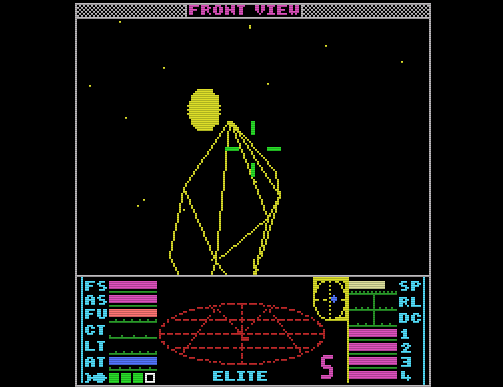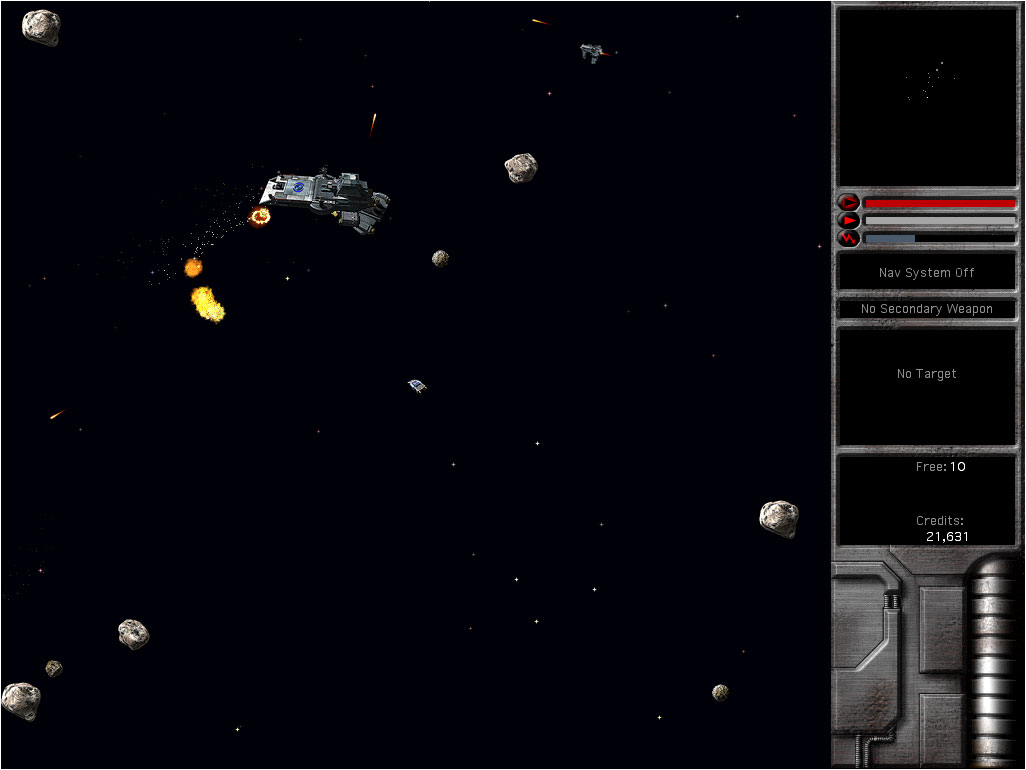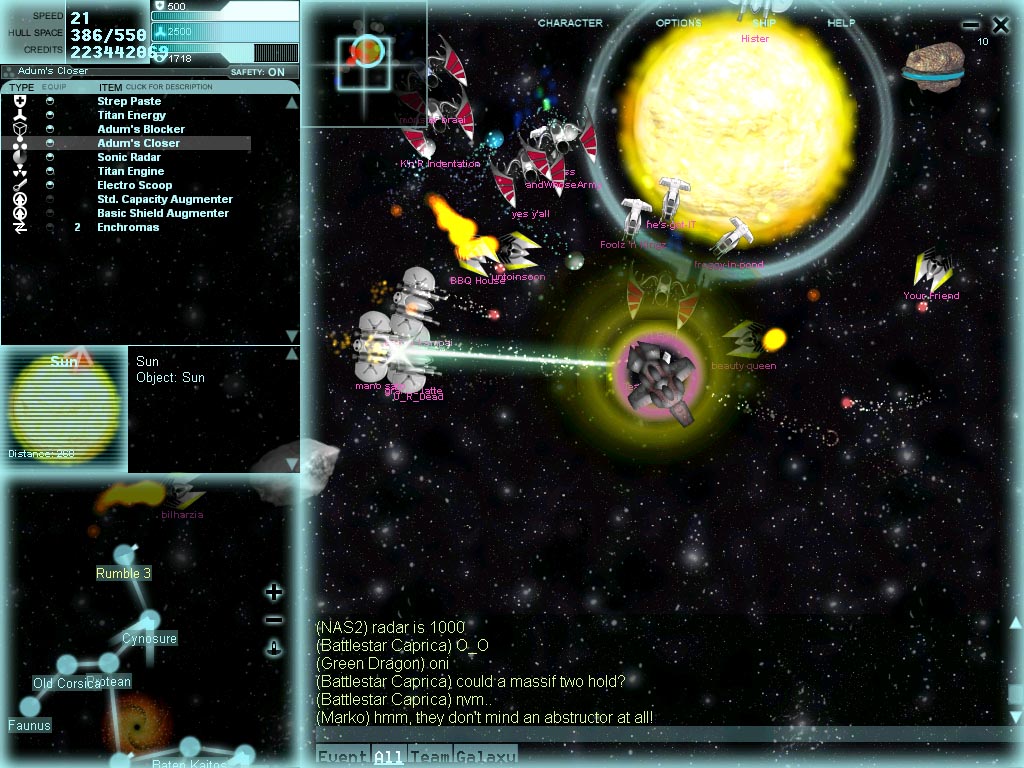Star Sonata
Dec 14, 2004 · peterb · 11 minute readGames
There is nothing new under the sun.
Nearly every videogame (or, for that matter, board game) one plays borrows mechanisms from one or more previous games. Innovation is rare. When we describe a game as being “novel” what we’re often referring to is a novel way of combining elements of previous games. I often complain about corporate games that blow their budget entirely on graphics and sound, but part of me understands why: it’s easier to innovate visually (or, to a lesser extent, in telling a story) than it is to develop a brand new type of gameplay that is still fun. So the big game companies are simply spending money where it will be most effective at distinguishing their product from the pack.
The one sentence description of Star Sonata is: “It’s nearly identical to Escape Velocity, except it’s online.” But of course, most people have probably never heard of Escape Velocity, so then I have to explain about the early 1980’s game Elite and how the space opera genre developed. So instead of talking about Star Sonata directly, let’s start at the distant end of this ball of yarn, and reel it in. In the dark old days of mainframes and minicomputers we had, of course, various “Star Trek” style games which involved flying around a (text rendered) galaxy, shooting klingons. There are also Spacewar and its descendants, which are among the earliest games played on a graphics display.
The true genesis of what I’m calling the “space opera” genre was also the genesis of one of the most successful game companies of the 1980s, Brøderbund. Doug Carlson, a practicing lawyer, wrote Galactic Empire for the TRS-80 in 1979. It was a clever and engaging game, and is still very playable even today (at the end of this article I will give links to versions for playing on Macs, natively, and on other platforms by emulation.) That game was one of four, collectively referred to as the Galactic Saga.
Galactic Empire took place in the star cluster RS-232 (groan if you want to). There were 20 inhabited worlds in this system, each of which could be identified by its starting initial. To this day, their distinctive names – some historical, some invented – linger in my memory, consuming valuable neurons. Alhambra. Bok. Ootsi. Javiny. Farside. The goal of the game was to conquer all 20 worlds via military force; you began on Galactica, a mid-size, medium-tech world with 200 ships. Each world had a potentially different population size and technology level; the larger the population, and the higher the technology level, the more difficult it was to conquer the planet. Once a planet was yours, you could levy taxes and manpower from it and have it build ships for you. For purposes of our present discussion, the following facets are significant: Galactic Empire is the first game that I’m aware of that had a “galaxy” of planets which you had to jump to; in other words, interstellar space was not significant. You didn’t simply fly around until you reached a destination, but rather moved directly from play area to play area.
The next game in the series, Galactic Trader, was built on the same engine, only instead of being a game of military conquest, the goal was simply “amass a billion dollars.” Each planet buys and sells a variety of commodities. Commodities originate at certain planets; the further away from that planet you are, the more you will be able to realize when you sell it (or, for a better deal, trade it for different commodities). The elements introduced in Galactic Trader will be seen in nearly every space trading game for years to come: hidden information (you don’t know the price of a good until you visit a star system), imperfect information (the price can change when you’re away), an economy with overhead (buying a good and then immediately selling it in the same place will always cause you to lose money), and automated tracking of information (the computer in Galactic Trader will keep track of what prices goods were selling for at each system you visit, although the information may be out of date. This was actually introduced in the previous game, although there it was used to track population and technology level.)
The final two games in the series, Galactic Revolution and Tawala’s Last Redoubt were variations on the theme of the first game, but with more complex victory conditions. I mention them here simply for the sake of completeness.

Fast forward to 1984: Ian Bell and David Braben introduce Elite for the BBC Micro computer (and quickly follow on with ports to many other 6502 based platforms, such as the Apple ][ and the Commodore 64). Elite is a game of space combat and trading. When not docked at a space station, the view is from the cockpit of your vessel; the game is rendered using polygonal 3D graphics, which was impressive at the time (Bill Budge had released a 3D vector graphics kit for the Apple ][ at around this time, but Elite looked much spiffier). Other games, of course, provided 3D views of spaceflight, both before and after. But what Elite brought that is relevant to this discussion is a merging of that with the trading concept of Galactic Trader. Also, since Elite involves space combat, making money so that you can upgrade your ship is critical. (In Trader, upgrades are simply about additional cargo capacity. In Elite they are a much more urgent matter).
The problem with Elite is that it turns out that flying through a real(ish) 3d space is (a) hard, and (b) boring. The first time you try to dock with a starbase and realize that, yes, you really do have to line up just perfectly and match your rotation with the docking bay, and not hit any other ships, and… well, let’s just say that although it has a devoted following, Elite is better appreciated as a fond memory than as a game. Which is a shame, because there is a lot of game there, and the only thing that kept many people from playing it more were the actual mechanics of flying around.
Which is why, 20 years later, people are still producing games that are basically “Elite, but without the annoying 3d docking/combat sequences.”
Probably the least famous of these is Galactic Trader for VMS, no financial or code relation to the Brøderbund game of the same name. This game takes the mise-en-scene, plot, and concept of Elite -- right down to the actual ship names – and places it in a text-only, menu-driven user interface. Which, if you’re old and slow like me, is great. Dexterity is completely removed from the equation (although, in typical VMS fashion, now you’re constantly querying help pages to remember the one and two character sequences you need to enter to undertake various operations.) This version of Galactic Trader is still around, and is worth at least trying for novelty’s sake (see below for links).

The pinnacle of the Elite-clone category is Escape Velocity. Originally a Mac-only game, it has now been ported to Windows. EV gets the balance exactly right. Gone is 3d combat; in it’s place is a simple 2d plane on which ships manuever and, sometimes, shoot at each other. Docking is as simple as moving your ship over a spaceport (or planet) and hitting the “land” key. EV also has its own (interesting) plot, rather than simply using the elements from Elite, and it is expandable via user-written modules and scripts. It’s a great game. I’ve been playing it for years.
Every time I talk with someone else who played EV, the topic eventually turns to online play. “Wouldn’t it be great if you could play EV online?” people ask? I’ve been noncommittal when discussing this. I enjoy online games as much as anyone, but I don’t believe that online play automatically makes all games better. I like cumin, too, but it tastes sort of funny on ice cream. Some games are better played offline.
So now that you know the history of space opera games, I can say: “Star Sonata is like Escape Velocity, only online,” and you’ll know what I mean. This isn’t the only possible geneology – we could talk about VMS Empire, which begat Civilization, which introduced the tech tree which has an impact in this game. Or we could trace a line from Empire to Reach For the Stars, which was the inspiration for Spaceward Ho, which was in turn shamelessly ripped off by Microprose for Master of Orion. But although all those games do have some influence here, I think the line I’ve described in detail is the most relevant one.

Star Sonata has a lot to recommend it. The graphics are both pretty and low- impact, so even on my comparatively low-end system, it looks great. The starfield is dual-layered, with the layers scrolling at different speeds when you move, creating the illusion of depth fairly effectively (if I recall correctly, Armada for the Dreamcast used a similar technique.) The game starts you in a small tutorial sandbox so you can play around without risk while you adjust to the controls. In short order, you are introduced to your weapons systems, the concept that you can only shoot something you have “targeted” or selected, the trading interface, and ship (and neural) upgrades. In no time at all you are out of the sandbox, and in the large, threatening, and confusing galaxy. In the context of a space opera, “large, threatening, and confusing” is a compliment. I spent my first hour in the game just jumping to random star systems, checking out space stations, and fleeing any combat I saw (there is no fuel for hyperspace jumps, so the only cost for exploration is your time).
The neural upgrade mechanism is interesting, and I feel a little conflicted about it. The idea is that each time you earn a level, you gain a number of character points that you can spend on training points; these points can apply to skills like piloting, weaponry, as well as some more advanced skills. When the time comes to purchase (or salvage) upgrades for your ship, you discover that any given item you could try to equip comes with a “rating.” You can only equip or use items that are rated at your skill level or below. So there are actually two gates you need to pass before you can put the megahuge laser on your ship: you have to get the money, and you have to earn the skill points. But you can only earn skill points by levelling up. And you can only level by earning experience points. And you can only earn experience points by destroying other ships. So while I don’t mind the idea of skill points per se, here’s yet another example of where a game’s progression system has a major impact on the narrative flow of the game, which is disappointing. In Escape Velocity it is perfectly possible to “role play” as a peaceful trader, amassing income, buying faster ships, with better shields, running away from combat. In Star Sonata, that’s not really a reasonable path.
One innovation that is extremely clever is the introduction of “slave AIs”. When you reach certain skill levels, you can purchase extra ships beyond the one you pilot, and an AI for the ship. Then you “train” the ship in what you want it to do (for instance, “go to this system, dock here, buy so many units of baobabs, undock, go to this system, sell the baobabs and buy nuclear waste, repeat…") Although I’ve seen macro systems in other games, this is the first space opera where I’ve seen it done. And it feels right: it fits the universe, it fits the game, and it’s clever. Star Sonata deserves kudos, if only for this feature.
The game plays slower than EV; this is a good thing. Given the requirements of shipping packets around the country to keep all the clients synchronized, maintaining an EV-like pace would guarantee that only those lucky enough to be lag-free would have a prayer of doing well. Thankfully, that’s not the case. The game feels a bit more contemplative than EV in this respect. There’s a lot of flying, a lot of waiting, a lot of travel time. But somehow, it isn’t annoying: it fits the genre. One thing that doesn’t fit are the trade goods; the inclusion of “crack whores,” among the trade goods, while perhaps entertaining to some, will probably just appear juvenile to others.
Star Sonata impresses me. I probably won’t play past the demo period, simply because my short attention span means that I am constitutionally incompatible with anything approaching the time commitment of a MMORPG. But the download of the fully-featured demo is free, so if you like space games, I think it’s worth your time to check it out.
Additional Resources
-
The Star Sonata web site has the demo available for free download.
-
If you’re interested in the sort of game I described here, you owe it to yourself to try out the superb shareware game Escape Velocity. Available for both Mac and Windows PCs.
-
You can download the original Brøderbund games for use in your favorite Apple ][ emulator here. If you have a Mac, you might want the updated “tribute” OS 9 ports (they run fine in OS X under Classic) of Galactic Empire and Galactic Trader, instead
-
You can play the text-only VMS version of GalTrad here, or just telnet to gt.gamingmuseum.com